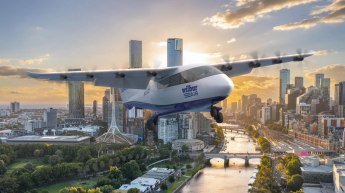It seems apt that thanks to the first non-stop scheduled flight between Australia and the UK we are all taking stock of the technological leap in passenger aviation over the past 70 years.
Shift that focus to just a decade after the first true powered flights around 1903 and we are talking not a leap but a revolution – though the basis was far more about victory in war than getting people from A to B.
With the advent of World War One the emergence of a “cavalry” of the air, not only as a means of spotting enemy troop movements but also as an aggressor and defender, saw the telescoping of technological development.
Within a year it delivered a transition from hand gun carrying pilots shooting aimlessly from crazily frail machines (some records tell of airmen lobbing bricks at one another) to relatively sophisticated aircraft with fuselage-mounted machine guns synchronised to shoot through the propeller arc.
At the same time a growing awareness of the strategic importance of air power compared with the relentless, bloody, grinding impasses of trench-bound warfare spurred a battle of a different kind: the race for superiority through the production of faster, more manoeuvrable types.
That meant the emergence of different designs for different military purposes and a jockeying for advantage that saw the Germans, French, British and ultimately Americans both boast and lose kudos for developing the best machines.

As Andrew Carter will tell you, this is the era of the Fokker Eindecker, the Sopwith Triplane, the Nieuport 24, the Bristol F2B, the SE5A, the Fokker D.VIII and, probably most famous of all (along with the Sopwith Camel), the Fokker Dr.I Triplane.
He should know. Apart from the Camel, Andrew – founding director of The Australian Vintage Aviation Society – partner Nathalie Gochel, engineer Dave Walsh and a group of dedicated volunteers, have driven the collection, restoration or reproduction of examples of each type.
The society collection, based at Caboolture just north of Brisbane, is a unique Australian tribute to an aspect of the Great War that, to date, has been largely overshadowed by centenary commemoration focussed first on Gallipoli and subsequently the horrors of the land-based battles of the Western Front.
And many of the TAVAS aircraft fly, including the instantly-recognisable bright red Fokker Triplane famously associated with the Red Baron, Manfred von Richthofen.
VIDEO – TAVAS was featured on Channel 9 news in 2014.
The weekend of April 21, the centenary of von Richthofen’s death, will see the Dr.1 take to the air again along with other aircraft from the collection in a fitting tribute to the World War 1 aces, pilots and observers of all nations.
The 2018 TAVAS Great War flying display on Saturday, April 21 and Sunday April 22 will combine World War 1 flight and static displays with exhibitions of several TAVAS pre-war aircraft, warbirds from the World War 2 era on, and other vintage types.
The venue is the Caboolture Airfield, Aerodrome Road, Caboolture, about an hour north of the Brisbane CBD and 50 minutes from Brisbane Airport. Pre-purchase tickets for adults are from $25 and children u-16 go free.
For Carter, authenticity is key: “When you come and see our (aircraft) you are literally transported back in time. The fabric on those aircraft is made by the same family run business that was making fabric for those aircraft back in 1915, ’16, ’17 and ’18. The method of construction is exactly as it was back then, the engines that are in them are exactly the same as they were back then, and we run castor oil, so it smells the same as it did back then.”

The show is a highlight of a period of intense activity for Carter and his small team since he and his partner established TAVAS in 2012. Not only have they gathered an impressive collection from scratch but they are also on the cusp of opening to the public on an ongoing basis.
Carter is wary of the tag museum because of the “musty” connotations. He wants his visitor centre to be anything but when it opens for business, hopefully just over a week before the show.
What can visitors expect?
Among a whole lot more, a dramatic display of all the TAVAS types, ceiling mounted aircraft, wall-mounted exhibitions and, importantly, an exhibition dedicated to the Australian aces of World War 1: 57 pilots and five observers.
“People are shocked when they find out we actually had pilots in World War 1. Then when you tell them we had aces they just don’t believe it,” Carter said.
“It’s all about putting that right.”

















Paul
says:There will be a single ship Rhino demo as well??
John
says:Don’t think the Super Hornet was flying in 1916 . Might want to change the caption on the pic
australianaviation.com.au
says:Probably not @John! Caption is now fixed, thanks for pointing it out!